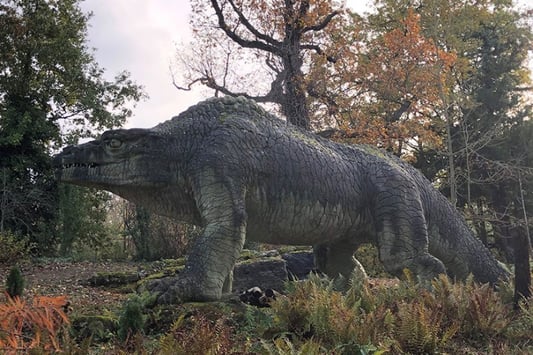June 1st is National Dinosaur Day and I am sure when I say the word dinosaur; you have an image of your favorite ancient reptile in mind. Whether it be a giant herbivore like the Brachiosaurus or a ferocious carnivore like Tyrannosaurus Rex; these animals have long held our fascination. It is very likely we found remains earlier, but the first scientific publication pertaining to dinosaur fossils comes from Europe in 1677. And it was not until 1841 that Sir Richard Owen coined the term dinosauria, meaning terrible lizard. According to the American Museum of Natural History there are now approximately 700 different recognized species of dinosaurs and they are culturally pervasive and easily recognizable. But how did we get from uncovering a mystery thigh bone fossil in the 17th century to bringing these ancient animals to life into the modern zeitgeist? The answer is the ever shifting combination of the fossil record and the practice of paleoart.

Early Depictions of Megalosaurus
The collection of all fossils is known as the fossil record. These fossils are the remains or traces of ancient organisms that are preserved in rocks over millions of years. There are several ways that fossils can form but the most common is through the process of permineralization. Permineralization happens when an organism dies and its body is buried by sediment like mud, sand, or volcanic ash. Over time, the sediment hardens into rock and minerals from groundwater seep into the spaces of the organism’s bones or other hard parts. These now mineralized bones create a replica of the organism, preserving its shape and structure. Other ways fossils form include molds and casts, which are created when an organism’s soft tissues decay and leave behind an impression in the sediment, and carbonization, which occurs when an organism is compressed and flattened in sediment, leaving behind a thin carbon film.

Modern Depiction of Megalosaurus
These various ancient remains and traces of the fossil record are the backbone of our modern interpretation of dinosaurs. It is the job of paleo-artists to take the scientific information gleaned from the fossil record and transform that into a visual representation of long extinct creatures. The constructed appearance of dinosaurs as we know them has changed along with our understanding of the fossil record. In the mid 1800’s, early depictions of dinosaurs were depicted as lumbering on all four legs and had mammalian characteristics. By the 1970’s the understanding of the fossil record vastly improved and dinosaurs were depicted as active and alert animals. As technology has improved in recent decades and skin pigments and soft tissue such as evidence of feathers have been discovered, colorful skin and plumage are a part of the modern dinosaur. In this way, although long extinct, the dinosaurs are ever changing. As you celebrate this National Dinosaur Day, keep in mind perhaps your favorite dino may look a little different than you remember from your childhood books and cartoons. And perhaps next year, your favorite dinosaur will continue to evolve as we learn more about the world of dinosaurs.
Scott Dunn is the Community Programs Manager at Walking Mountains Science Center. He wanted to grow up to be a dinosaur but has had to settle for a less robust reptilian lifestyle of writing about dinosaurs for local newspapers.







